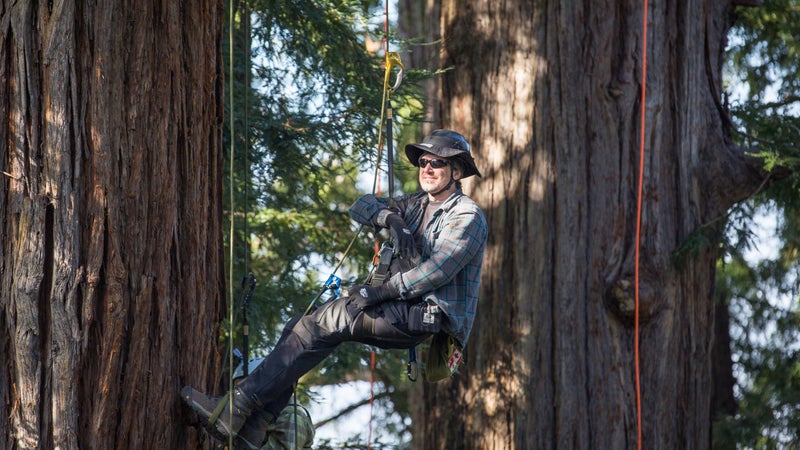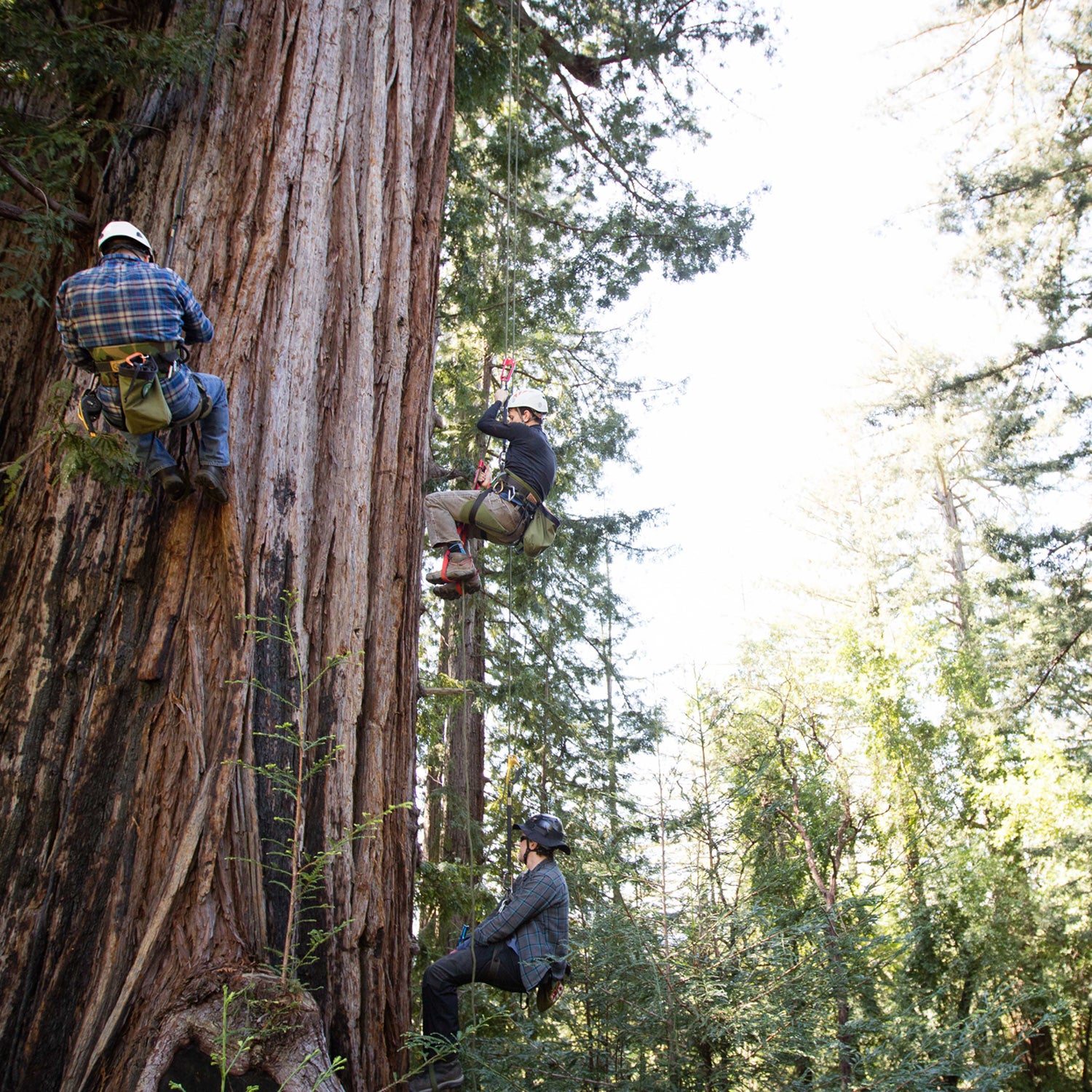I was about 100 feet up the tree when I dropped my pen.
Some ten feet below me, Tim Kovar, probably the world’s most sought-after tree-climbing expert, shot out his right hand to catch it. Kovar, a large man with long limbs, was wearing a black helmet outfitted with a black wrap-around visor, which, from my viewpoint, made him look a bit like Darth Vader’s arboreal cousin. The pen landed in his palm, but bounced out and disappeared through branches under him. “Oh!” he blurted in frustration, then shook his head. He was clearly used to making the catch.
It was a gorgeous early spring afternoon in Northern California’s Santa Cruz Mountains. We were climbing an old-growth redwood that was roughly 200 feet tall and somewhere between 600 and 1,000 years old. With us were several other guided climbers as well as a canopy scientist from the University of California, Berkeley. Kovar is the founder and owner of , which runs recreational courses on a 150-acre forested farm near Portland, Oregon, from May through October. During the winter months, he leads tree-climbing expeditions to the tropics and helps research teams access canopies from India to Costa Rica.
Once a year, Kovar takes small groups up Grandfather, as this redwood is known. It’s nearly impossible to legally scale any of the old-growth redwoods in national or state parks, but Grandfather is on private property. The owners sought out Kovar after reading about him in Richard Preston’s 2007 book, (Kovar was Preston’s personal climbing instructor), to see if he might want to bring adventurers and scientists up the big redwood.
“Think of tree climbing as a place to be, rather than something to do.”
Reaching the top of a giant like Grandfather is an irresistible life list opportunity for many people, and Kovar has hosted climbers here from around the world. My group included a local winemaker in his 40s, a young arborist from the U.K., and his sixty-something-year-old mother, who wore a T-shirt that read, CLIMB NOW WORK LATER. The previous day, Kovar had guided a man who’d traveled from Dubai for the experience. Seeking to limit impact on the tree, Kovar only leads one series of climbs here every spring, so Grandfather can have a year to recover. His waiting list is 40 names long.
Kovar's Oregon courses, which take place on oaks, are focused on training people to scale trees on their own, but here in the redwoods he only sought to share his passion. “Think of tree climbing as a place to be, rather than something to do,” he said as we strapped into specialized tree-climbing harnesses Kovar called saddles because they're designed for long periods of sitting. As long as we followed his instructions, we’d be totally safe. To date, Tree Climbing Planet has taken tens of thousands of climbers up trees, with no serious accidents—just “a few haircuts” from ropes snagging the locks of clients who ignored suggestions to tie up their 'dos.
A few minutes later, we clipped into 400-foot static ropes Kovar had anchored near the top of the tree. He had set them a couple days earlier, using a crossbow to get a lightweight line over a tall branch, then using that to pull the first big rope over. To reduce impact on Grandfather, we used Petzl ascenders to inchworm our way up, only touching the tree when we passed by branches.
As we made our way into the canopy, our small group quickly coalesced into a unit, much the way strangers in a whitewater raft suddenly become a team. This dynamic is what drew Kovar to become a guide and instructor far more than his own love of climbing. He was an arborist until, in the early 1990s, be began doing some work with Tree Climbers International, in Atlanta—at the time the only school anywhere offering instruction for recreational climbers. Early on, Kovar was given a group of students that included two older women, a young rocker with a blue mohawk, and a conservative southern couple. “They had nothing in common, but up there in the trees, they got along perfectly,” he said. “That was it. After that I started teaching all the time.” He became TCI’s top instructor and eventually founded Tree Climbing Planet and moved to Oregon.
Up, up, up we went—in Grandfather, that’s the only direction to go. As we took a break to scope out a massive lightning scar on another nearby redwood, Kovar confessed that while he enjoys climbing the world’s tallest tree species, he prefers oaks with massive, twisting branches. “In a redwood, it’s Everest, but you only go straight up,” he said. “In Oregon, we hang these giant hammocks between the oak branches and just chill out, or sleep for the night.”

His most challenging climbs are in the tropics. “In the Amazon, you can be 50 feet into a tree and then switch over to a strangler fig that isn’t even rooted to the ground,” he explained. “Psychologically, that gets to me.” Then there are all the “creepy crawlies.” Over the years, Kovar has helped scientists look for king cobras in India and eyelash vipers in Panama, among other venomous critters. “In those environments, the safest space is on the rope versus on the trunk or branches, where you might have snakes.” That’s not to say confining yourself to your harness guarantees clear passage. “When you’re 80 feet up a rope and you look up and 1,000 ants are on it coming your way, the only choice is to go down,” he said with a chuckle.
There’s life in the redwood canopy, too, of course. According to a 2007 survey by Cameron Williams, the UC Berkeley doctoral candidate who climbed Grandfather with us, coastal redwoods are home to an astounding 282 species of epiphytes, or plants that grow by collecting water from the air and often live on other plants. As we reached the tops of our ropes, we spotted a posse of acorn woodpeckers in the closest redwood along with thousands of their their telltale storage holes. Above us, two ravens hounded a shrieking red-shouldered hawk.
We lingered near Grandfather’s crown, taking in a view of forested hillsides leading down to Santa Cruz and the Pacific. We chatted for a while, but mostly we just hung there quietly. Nobody wanted to head down, including Kovar.
After the roughly 175-foot rappel to the forest floor, we circled up to debrief. The arborist’s mom was ecstatic. “I feel like there’s nothing I can’t do!” she exclaimed. She turned to Kovar and put her hand on his shoulder. “Tim, you must love making people this happy.”
Kovar smiled. “I always say, I love the people the trees bring to me.”


